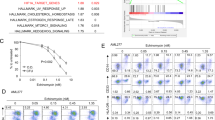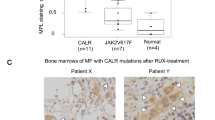Abstract
The purpose was to investigate the role of EphB4 in imatinib (IM) resistance and the mechanism responsible for homoharringtonine (HHT) contributing to imatinib sensitivity for a chronic myeloid leukemia (CML) cell lines. We established cell lines from a patient with CML at the time of first diagnosis and relapsed phase and designated them as NPhA1 and NPhA2, respectively. Stable underexpressing EphB4 cells (NPhA2-sh) were obtained. The activated signal proteins in cells were tested by Western blot. The EphB4 was overexpressed in IM-resistant NPhA2 in comparison with the NPhA1 cell line, but the expression of EphB4 mRNA and protein significantly decreased in knockdown NPhA2-EphB4-sh cells compared with NPhA2 and NPhA1 (P < 0.001) cell lines. NPhA2-EphB4-sh cells were sensitive to IM (IC50 0.93 mg/L), and NPhA2 showed IM resistance (IC50 5.45 mg/L) (P < 0.001). Meanwhile, phospho-Rac1/cdc42 was significantly increased in NPhA2 cells compared to NPhA2-EphB4-sh (P < 0.001). The apoptosis rate reached 58.71 ± 2.39 % with NPhA2 cells incubated with HHT + IM, which was higher than NPhA2 cells incubated with IM alone (P = 0.002). IC50 of NPhA2 cells incubated with IM was 5.45 mg/L. However, co-stimulation with HHT + IM decreased the IC50 of NPhA2 cells from 5.45 to 1.17 mg/L (P < 0.001). Furthermore, HHT blocked the expressions of EphB4/RhoA, but did not down-regulate the phospho-MEK/ERK in NPhA2 cells. The overexpression of EphB4 contributed to IM resistance in CML line cells. EphB4/RhoA may be a new marker of IM resistance. HHT + IM gained more treatment advantages than IM alone by blocking EphB4/RhoA pathways in CML cell lines.




Similar content being viewed by others
References
Hochhaus A, O’Brien SG, Guilhot F, Druker BJ, Branford S, Foroni L, et al. IRIS investigators: six-year follow-up of patients receiving imatinib for the first-line treatment of chronic myeloid leukemia. Leukemia. 2009;23:1054–61.
Druker BJ, Guilhot F, O’Brien SG, Gathmann I, Kantarjian H, Gattermann N, et al. IRIS investigators: five-year follow-up of patients receiving imatinib for chronic myeloid leukemia. N Engl J Med. 2006;355:2408–17.
Druker BJ, Sawyers CL, Kantarjian H, Resta DJ, Reese SF, Ford JM, et al. Activity of a specific inhibitor of the BCR-ABL tyrosine kinase in the blast crisis of chronic myeloid leukemia and acute lymphoblastic leukemia with the Philadelphia chromosome. N Engl J Med. 2001;344:1038–42.
Sawyers CL, Hochhaus A, Feldman E, Goldman JM, Miller CB, Ottmann OG, et al. Imatinib induces hematologic and cytogenetic responses in patients with chronic myelogenous leukemia in myeloid blast crisis: results of a phase II study. Blood. 2002;99:3530–9.
Noren NK, Pasquale EB. Paradoxes of the EphB4 receptor in cancer. Cancer Res. 2007;67:3994–7.
Giles FJ, O’Dwyer M, Swords R. Class effects of tyrosine kinase inhibitors in the treatment of chronic myeloid leukemia. Leukemia. 2009;23:1698–707.
Nakamoto M, Bergemann AD. Diverse roles for the Eph family of receptor tyrosine kinases in carcinogenesis. Microsc Res Tech. 2002;59:58–67.
Suzuki M, Abe A, Imagama S, Nomura Y, Tanizaki R, Minami Y, et al. BCR-ABL-independent and RAS/MAPK pathway-dependent form of imatinib resistance in Ph-positive acute lymphoblastic leukemia cell line with activation of EphB4. Eur J Haematol. 2010;84:229–38.
Ohmine K, Nagai T, Tarumoto T, Miyoshi T, Muroi K, Mano H, et al. Analysis of gene expression profiles in an imatinib-resistant cell line, KCL22/SR. Stem Cells. 2003;21:315–21.
Tujebajeva RM, Graifer DM, Karpova GG, Ajtkhozhina NA. Alkaloid homoharringtonine inhibits polypeptide chain elongation on human ribosomes on the step of peptide bond formation. FEBS Lett. 1989;257:254–6.
Zhou JY, Chen DL, Shen ZS, Koeffler HP. Effect of homoharringtonine on proliferation and differentiation of human leukemic cells in vitro. Cancer Res. 1990;50:2031–5.
Li R, Liu XL, Du QF, Zhang S, Zhou SY. Two-dimensional polyacrylamide gel electrophoresis analysis of apoptosis in K562 cells induced by harringtonine. Ai Zheng. 2004;23:1155–60.
Harnois T, Constantin B, Rioux A, Grenioux E, Kitzis A, Bourmeyster N. Differential interaction and activation of Rho family GTPases by p210 bcr-abl and p190 bcr-abl. Oncogene. 2003;22:6445–54.
Kuzelová K, Hrkal Z. Rho-signaling pathways in chronic myelogenous leukemia. Cardiovasc Hematol Disord Drug Targets. 2008;8:261–7.
O’Brien S, Talpaz M, Cortes J, et al. Simultaneous homoharringtonine and interferon-alpha in the treatment of patients with chronic phase chronic myelogenous leukemia. Cancer. 2002;94:2024–32.
Fang B, Li N, Song Y, Han Q, Zhao RC. Standard-dose imatinib plus low-dose homoharringtonine and granulocyte colony-stimulating factor is an effective induction therapy for patients with chronic myeloid leukemia in myeloid blast crisis who have failed prior single-agent therapy with imatinib. Ann Hematol. 2010;89:1099–105.
Acknowledgments
This work was supported by the Natural Science Foundation of Inner Mongolia (2013MS1157).
Conflict of interest
I would like to declare on behalf of my co-authors that this work is original research that has not been published previously and is not under consideration for publication elsewhere, either in part or in whole. All the authors listed have approved the manuscript that is enclosed.
Author information
Authors and Affiliations
Corresponding author
Additional information
Bin-Tao Huang and Qing-Chun Zeng have contributed equally to this work.
Rights and permissions
About this article
Cite this article
Huang, BT., Zeng, QC., Zhao, WH. et al. Homoharringtonine contributes to imatinib sensitivity by blocking the EphB4/RhoA pathway in chronic myeloid leukemia cell lines. Med Oncol 31, 836 (2014). https://doi.org/10.1007/s12032-013-0836-9
Received:
Accepted:
Published:
DOI: https://doi.org/10.1007/s12032-013-0836-9




